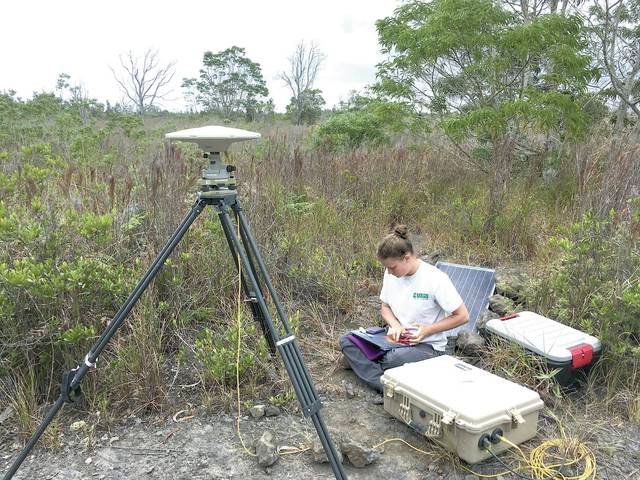The USGS Hawaiian Volcano Observatory has an extensive network of instruments that helps us monitor how the ground deforms due to magma moving underground. However, we are fortunate that scientific colleagues also pitched in to support our responses to Kilauea Volcano’s lower East Rift Zone eruption and summit collapse.
Here, we describe our deformation monitoring network and highlight how the community of scientists who study ground motion helped increase HVO’s monitoring capabilities during Kilauea’s recent events.
GPS has been used to monitor surface motion on the Island of Hawaii since the late 1980s. Several dozen permanent GPS stations are scattered around the island, and all communicate data to HVO via radio links. Each day, an independent solution for the three-dimensional position of a GPS station is calculated from these data. The accuracy of the GPS station positions is typically better than a centimeter (a fraction of an inch).
In addition to permanent GPS stations, which are affixed to a monument anchored to the ground, HVO also regularly measures the positions of a set of benchmarks using portable installations, also called “campaign GPS.” During an eruption, these temporary stations provide extra coverage in important areas.
One challenge of the LERZ eruption, which began May 3 in lower Puna’s Leilani Estates subdivision, was that it involved a large portion of Kilauea. Within days of the first fissure opening, all HVO GPS equipment was deployed, but gaps remained in places where ground deformation monitoring was critical.
Fortunately, the University Navstar Consortium (UNAVCO), a Colorado-based organization that specializes in using GPS to measure deformation of Earth’s surface, was able to provide additional equipment to expand the area that HVO could monitor. This expanded area included the western side of Kilauea’s south flank, which enabled us to gather more insights on the aftereffects of the magnitude-6.9 earthquake that occurred May 4.
Additional GPS stations were deployed along Kilauea’s middle East Rift Zone, from Pu‘u ‘O‘o to Heiheiahulu, to measure rift deformation caused by magma draining from the area and migrating to Leilani Estates. Other temporary stations were deployed around Kilauea caldera to give better constraints on summit deflation and collapse.
Another tool used by HVO to measure surface deformation orbits above Earth’s surface at a height of more than 600 kilometers (about 400 miles) — satellites.
Specifically, radar satellites. Interferometric Synthetic Aperture Radar is a technique that uses two satellite radar images acquired from about the same point in space at different times. From these images, a map can be produced to show how the Earth’s surface deformed during the time spanned.
The European Space Agency operates a two-satellite constellation called Sentinel-1. InSAR data from Sentinel-1 are typically available with a 12-day repeat cycle. However, in response to Kilauea’s eruption and summit collapse events, ESA cut the repeat time in half, and provided InSAR results every six days.
The Cosmo-SkyMed satellite system is operated by the Italian Space Agency and consists of four satellites. ASI made sure all four satellites acquired high-resolution views of Kilauea’s summit throughout the collapse events, with individual InSAR results spanning as little as one day.
The increased frequency of SAR satellite passes was especially valuable for regular updates and broadscale views of Kilauea’s summit, allowing HVO to monitor subtle surface deformation that might otherwise have gone undetected. The data also were used to produce animations of the summit collapse, which provided scientists and island residents a bird’s-eye view of the major changes occurring within Kilauea caldera.
HVO scientists used the additional equipment and access to satellite data to further our monitoring capabilities and better understand Kilauea’s extraordinary LERZ and summit activity. We are grateful for the scientific community’s support, which was crucial to understanding the evolution of volcanic hazards during the course of the recent unprecedented events.
Volcano
activity updates
At Kilauea’s lower East Rift Zone, no incandescence was visible in the fissure 8 cone and no lava was entering the ocean as of Aug. 30. At the summit of the volcano, seismicity and ground deformation were negligible, and no collapse event has occurred since Aug. 2. However, hazardous conditions remain in both areas. Residents in the lower Puna and Kilauea summit areas should stay informed and heed Hawaii County Civil Defense closures, warnings and messages (http://www.hawaiicounty.gov/active-alerts). HVO daily status reports are posted at https://volcanoes.usgs.gov/volcanoes/kilauea/status.html.
At Mauna Loa, HVO geophysical monitoring networks indicate earthquakes and deformation are near background levels, and the USGS Volcano Alert level for the volcano remains at Normal.
HVO continues to closely monitor Kilauea and Mauna Loa and will report any significant changes on either volcano.
No earthquakes were reported felt in Hawaii this past week.
Visit HVO’s website (https://volcanoes.usgs.gov/hvo) for past Volcano Watch articles, Kilauea daily eruption updates, Mauna Loa monthly updates, volcano photos, maps, recent earthquake info, and more. Email questions to askHVO@usgs.gov.
Volcano Watch (https://volcanoes.usgs.gov/hvo/hvo_volcano_watch.html) is a weekly article and activity update written by U.S. Geological Survey Hawaiian Volcano Observatory scientists and affiliates. This week’s article is by HVO geophysicist Sarah Conway.






